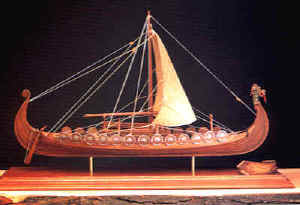|
Section Plan
View of Gokstad Viking Ship
Particularly worthy of
note in this close-up detailed Section Plan View of the Gokstad is the
Mast Partner. You will find this drawing in the section titled:
'Construction Methods,' along with detailed analysis of the history of
the boat building methods employed by the Vikings in the building of the
Gokstad and other Viking ships.
The following account is the result of a new examination of the
ship (1943-44)
"Every part of the planking is carefully formed according to its
function. The first 9 strakes from the keel, forming the bottom below
the waterline, are of elastic planks 1" (2.6 cm.) thick, mostly
lashed to the ribs with withy, and not nailed. It is a very curious
construction, a legacy from the early, primitive stages of
ship-building, still used in the Viking Era although at that time a more
simple technique could surely have been found. On the inside of the
planking, in the middle of each strake and in one piece with it, are
rows of protruding cleats. This is a very nice piece of carpentry, as
the cleats are cut out during the process of reducing the boards to the
desired thickness The cleats are so placed that each one is directly
under its corresponding rib and through each cleat two holes are made,
one on each side of the rib. Then two holes are made through the rib, on
both sides of the cleat. Next, lashings are put through the holes of
both ribs and cleats, tying them together. The cleats are so cut that
the upper edge of the plank is against the rib, while the lower edge is
outside and overlapping the plank below. In the Gokstad ship, lashings
of fine spruce roots were used.
This construction is used for the second strake
and those above, up to, and including the eighth. The first, garboard
strake is riveted on to the ridge on the side of the keel and to the
second strike, with no other fastening. The 9th strake, the last of the
strakes below the waterline has no lashing cleats, but is fastened to
the ribs with a treenail. At the point of contact between the rib and
the planking there is a broad cleat that begins as a ridge approximately
in the middle of the strake, so that the lower edge can be placed
outside the strake below. Thus we see that the various strakes differ
according to their place and function in the hull. All this had to be
carefully planned, measured and cut before the planking was riveted
together. By a close examination of the ship one almost feels as if one
could follow the movement of the sure and well-trained hands that worked
here."
This particular view is not
included in the Gokstad Plans, and we recommend book marking this Web
site for future reference.
All pages on this Web site contain additional details
concerning Viking ships, links to
other pages in this site, and other relevant sites.
For information on nonprofits and the program
we are currently working on to help breach the 'Digital Divide' visit Merisol
Services, Inc. at: http://www.geocities.com/merisol_services
|





